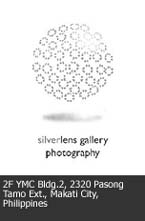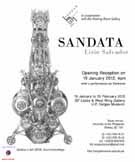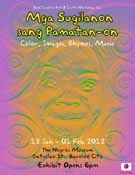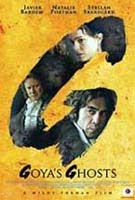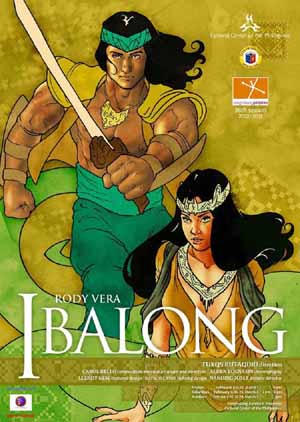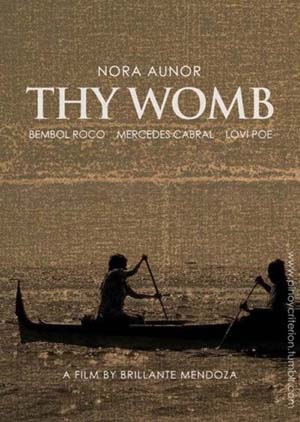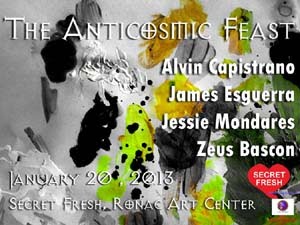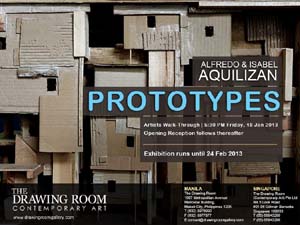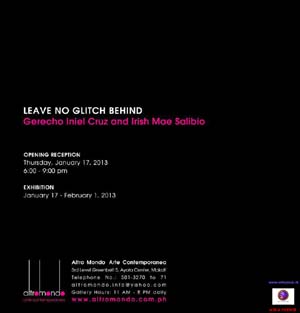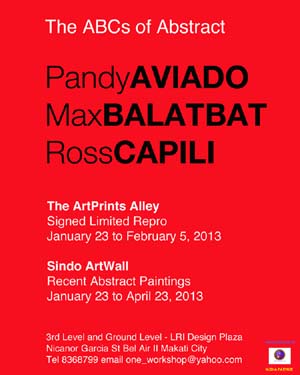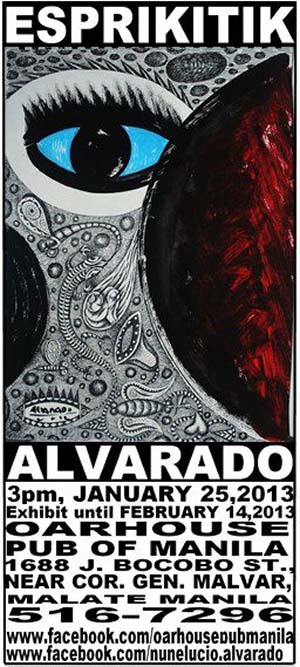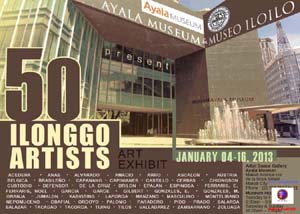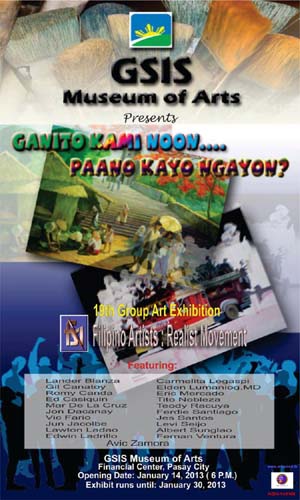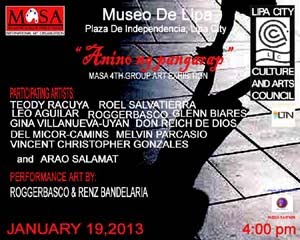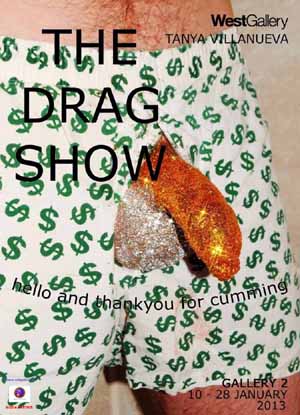

NEWS
Wednesday, August 31, 2011
ART ON TRIAL: CASE 4

The Issue: Religious Freedom and Artistic Expression
In addition to prohibiting laws that abridge freedom of speech, the First Amendment to the United States Constitution bars laws “respecting an establishment of religion." Referred to as the "establishment clause," the U.S. Supreme Court has interpreted this provision as prohibiting the government from endorsing one religion over another, or even endorsing religion over no religion. Unfortunately, this mandate is easier to state than practice when it comes to artistic expression. For example, in a government sponsored art exhibit, does the establishment clause prohibit the entry of any and all works with a religious theme, or does the exclusion of such works violate the free speech rights of artists? In this and similar circumstances, the establishment clause and the right of free speech appear to be in conflict. Courts must struggle to balance these two respective First Amendment rights in light of the particular facts of the case before them. As such, the results in these cases are determined less by a clear legal standard than they are by the individualized circumstances of each case.
The Case: O'Connor, et. al. v. Washburn University, et. al.
Washburn University is a public institution located in Topeka, Kansas. Each year the University sponsors an outdoor sculpture contest as a means to beautify the campus and stimulate discussion of art and its meaning. Once selected, the winning entries are displayed around campus for several months. One of the 5 winning entries for the 2003 contest was a sculpture by artist Jerry Boyle of Longmont, Colorado. Entitled Holier Than Thou, the work shows the upper body of a clergyman wearing a miter, the tall hat commonly worn by Catholic bishops, cardinals, and popes. Controversy erupted soon after the sculpture was placed on the Washburn campus. Critics contended that the clergyman was portrayed with a grotesque facial expression and that the ceremonial hat he wore resembled a phallus. The statue so greatly offended a Washburn professor and student that they filed a lawsuit in federal court demanding the removal of the statue. The two plaintiffs alleged that the statue conveyed an impermissible state-sponsored message of disapproval of the Catholic faith and religion. The Tenth Circuit Court of Appeals disagreed. The court concluded that neither the purpose nor the effect of displaying the sculpture was to spread an anti-Catholic sentiment. The court went on to say that, viewed in context with the other sculptures displayed on campus, "any reasonable observer... would understand the university had not endorsed that message."
http://www.tjcenter.org/ArtOnTrial/religious.html
Holier Than Thou
(bronze sculpture)
by
Jerry Boyle
Tuesday, August 30, 2011
ART ON TRIAL: CASE 3

The Issue: Violent and Threatening Imagery
The Issue: Artistic Expression in Public Schools
In 1969, the U.S. Supreme Court determined that "true threats" of violence was among those categories of speech that are not protected by the First Amendment. What constitutes such a "true threat," however, is often difficult to distinguish from constitutionally protected speech. Although lower federal and state courts have adopted varying legal standards for making this determination, all rely heavily on the context in which the expression took place. Thus, expression that is reasonably understood to be an artistic statement is protected by the First Amendment even if it depicts disturbing acts of violence. On the other hand, expression that a speaker does not intend as a threat, but a listener reasonably interprets as such, may be punishable.
In the context of public schools, the U.S. Supreme Court has determined that students do not "shed their constitutional rights to freedom of speech or expression at the schoolhouse gate." Yet the Supreme Court has made it equally clear that school authorities have a strong and valid interest in maintaining discipline and carrying out their educational mission. The pursuit of these goals sometimes allows restrictions on speech within the public school context that would not be tolerated elsewhere. As a result, lower courts often give great deference to the decisions of school administrators, sustaining their actions so long as they are reasonably related to a legitimate educational goal. One such goal, preventing disruption of the school environment, has often been cited as the justification for punishing students who create an artistic work that school administrators find threatening or otherwise inappropriate for the school setting.
The Case: Boman v. Bluestem Unified School District No. 205
In 2000, seventeen year-old high school senior Sarah Boman created a poster for her art class at Bluestem High School in Leon, Kansas. The poster contains a narrative, written in the first person, exploring the question, "Who killed my dog?" The narrative (text below) was not presented in the traditional format of left to right but rather in a clockwise spiral making it somewhat difficult to read. Included in the narrative were the statements, "I'll kill you if you don't tell me who killed my dog," and "I'll kill you all!" Boman, an accomplished art student, stated her piece was a work of art that reflected no personal experience with a dog.
Initially, Boman was permitted to hang the poster on a door in a school hallway. The school's principal subsequently saw the poster, found it disturbing, seized it, and ordered an investigation. A few days later, Boman was suspended from school for the remainder of the year, approximately 81.5 days. Despite the conclusions of the school district's investigator that Boman did not intend to threaten anyone and that the suspension should be dropped, the Bluestem Board of Education ordered that she undergo (and "pass") a psychological evaluation before being allowed back in school. Boman sued the school district in federal court for an injunction to return to school. The U.S. District Court for the District of Kansas granted the injunction, finding that Boman's work neither constituted a threat nor caused a substantial disruption at her school.
Text of Poster:
Please tell me who killed my Dog.
I miss him very much - He was my best friend.
I do miss him terribly.
Did you do it?
Did you kill my dog?
Do you know who did it?
You know, don't you?
I know you know who did it.
You know who killed my dog.
I'll kill you if you don't tell me who killed my dog.
Tell me who did it.
Tell me. Tell me. Tell me.
Please tell me now.
How could anyone kill a dog?
My dog was the best.
Man's best friend.
Who could shoot their best friend?
Who?
Dammit, Who?
Who killed my dog?
Who killed him?
Who killed my dog?
I'll kill you all!
You all killed my dog.
You all hated him.
Who?
Who are you that you could kill my best friend?
Who killed my dog?
http://www.tjcenter.org/ArtOnTrial/threats.html
Who Killed My Dog
(14" x 20" pen and ink poster)
by
Sarah Boman
ARTICLE 19

ARTICLE 19 champions freedom of expression and the free flow of information as fundamental human rights that underpin all others. We take our name from Article 19 of the Universal Declaration of Human Rights. It states: Everyone has the right to freedom of opinion and expression; the right includes freedom to hold opinions without interference and to seek, receive and impart information and ideas through any media regardless of frontiers.
ARTICLE 19 believes that freedom of expression and of information is not a luxury but a basic human right: it is central to achieving individual freedoms and developing democracy.
When people are denied freedom of speech or access to information, they are denied the right to make choices about their lives. Freedom of expression and access to information are essential to achieving equality for women and minorities, and to protecting children's rights. They are crucial to respond to the global HIV/AIDS pandemic, to fight against corruption and to ensure equitable and sustainable development.
ARTICLE 19 works to make freedom of expression a reality all over the world:
•ARTICLE 19 works worldwide – in partnership with 52 local organisations in more than thirty countries across Europe, Africa, Asia, Latin America and the Middle East - to lead institutional, cultural and legal change.
•ARTICLE 19 monitors threats to freedom of expression in different regions of the world and develops long-term strategies to combat them.
•ARTICLE 19 undertakes authoritative and cutting edge research and monitoring, advocacy and campaigning work.
•ARTICLE 19 produces legal analysis, set standards, and advocate for legal and judicial changes.
•ARTICLE 19 carries out advocacy and training programmes in partnership with national NGOs to enable individuals to exercise their human rights.
•ARTICLE 19 engages international, regional and State institutions, as well as the private sector, in critical dialogue.
Founded in 1986, ARTICLE 19 was the brainchild of Roderick MacArthur, a US philanthropist and journalist. Its International Board consists of eminent journalists, academics, lawyers and campaigners from all regions of the world. ARTICLE 19 is a registered UK charity (UK Charity No. 327421) based in London with international staff present in Africa, Latin America and Canada. We receive our funding from donors and supporters worldwide who share a commitment to freedom of expression.
ARTICLE 19, 6-8 Amwell Street, London EC1R 1UQ, United Kingdom. Tel: +44 20 7278 9292 Fax: +44 20 7278 7660 info@article19.org http://www.article19.org
Monday, August 29, 2011
ART ON TRIAL: CASE 2

The Issue: Counterfeiting
Few should be surprised to learn that federal law prohibits the reproduction or forgery of U.S. currency and other securities. Yet there are exceptions to that prohibition. Illustrations of currency are permitted if they are significantly different in size to actual currency and are produced in black and white. Color illustrations of currency are only permitted if the term "non-negotiable" is printed across the center of the illustration in a font at least one quarter inch high. Reproductions that do not meet these requirements are illegal even if they bear only a partial resemblance to actual currency.
The Case: Boggs v. Bowron
J.S.G. Boggs is an artist who draws, prints, and otherwise replicates the paper currency produced by various countries, including the United States. His “Boggs Bills” typically feature the same size, coloration, design patterns, and symbols as the bills he is inspired by, but with a few noticeable variations usually aimed at comedic effect. There is no evidence that he has ever attempted to pass his bills off as authentic currency, or that his “bills” have been mistaken for the real thing.
Nonetheless, in 1991, U.S. Secret Service agents seized 15 of Boggs’ pieces from an exhibit in Cheyenne, Wyoming. The following year, Secret Service agents seized the majority of Boggs’ remaining work from his studio, home, and office at Carnegie Mellon University. In neither instance, however, was Boggs charged with counterfeiting. In 1993, Boggs sued for the return of his work, claiming the seizure of his work violated his First Amendment right of free speech. He argued the counterfeiting statute was written too broadly, allowing law enforcement officials to apply it to works never mistaken for actual currency. His legal efforts were unsuccessful. Both trial and appellate courts upheld the seizure of Boggs' work, finding that the federal statute served the government interest of preventing counterfeiting without unduly restricting free expression. To this day Boggs has never been charged with counterfeiting, yet his work remains in the possession of the Secret Service.
http://www.tjcenter.org/ArtOnTrial/counterfeiting.html
Boggs' Bills
(6 & 1/4" x 2 & 1/2")
by
J.S.G. Boggs
AQUABELLA 2011

Impy Pilapil's "The Spiral"
Sculptor Impy Pilapil presents her latest series of works in simultaneous exhibitions opening on September 1, 2011 at the Alliance Française Total Gallery (Aquabella 2011) and on September 3 at the Avellana Art Gallery. The theme is inspired by the constant quest for knowledge on the mysteries of physical and spiritual life and how better understanding fulfills our role as human beings in this universe.
Steel, stone and glass are harnessed into forms that allude to the unseen and often ignored phenomena in our world. We encounter her signature liquid forms along with fresh new ones that evoke her latest subject matter: The Spiral.
The Spiral secretly manifests itself in all forms of life. With the sun’s spiral orbit, as the progenitor of all life on this planet, it subtly appears in growth patterns of all living organisms, weather conditions, and even evolution itself –showing how all life is connected by unseen mysterious forces that transcend material existence.
Impy Pilapil’s exhibition “Aquabella 2011” opens on Thursday, September 1, 2011, at the Alliance Française Total Gallery of the Alliance Française de Manille, with cocktails at 6:30pm to 9pm. The exhibit runs until September 29, 2011. For high resolution images of the artworks and more details about the exhibit, kindly contact Mr. Earl Parco (AFM Cultural Officer) at 895 7441 / 895 7585 or email cultural@alliance.ph, or visit the AFM website at www.alliance.ph.
Alliance Française de Manille is located at 209 Nicanor Garcia St. formerly Reposo St.) Bel-Air 2, Makati City. Gallery days and hours: Monday to Thursday, 9am to 6pm; Friday and Saturday, 9am to 5pm; and closed on Sundays and Holidays.
Impy Pilapil’s exhibition “Aquabella 2011” is co-presented by Avellana Art Gallery (located at 2680 FB Harrison St, Pasay City, Philippines, 1300. Tel: 8338357).
Sunday, August 28, 2011
ART ON TRIAL: CASE 1

The Issue: Obscenity and Art: Nudity
In the 1942 case of Chaplinsky v. New Hampshire, the U.S. Supreme Court declared that "obscenity" was a type of speech not protected by the First Amendment. As with several other narrow categories of speech listed by the Court, obscene expression was undeserving of First Amendment protection because it played "no essential part of any exposition of ideas" and was "of such slight social value as a step to truth that any benefit ...derived from [it] is clearly outweighed by the social interest in order and morality."
But what is obscenity? The definition is often in the eye of the beholder. Some people are offended by any depiction of human nudity, while for others, even highly sexual images are a classical form of artistic expression. Even Supreme Court Justice Potter Stewart struggled to come up with a coherent definition of obscenity, declaring in 1964, "I know it when I see it." Since then, the Supreme Court has articulated a more precise terminology, making it clear that nudity alone does not make an image obscene. The Court's 1973 guidelines for defining obscenity, laid out in the case of Miller v. California, are still being used today.* But haziness remains: even now, it is difficult to predict with certainty what material courts will classify as unprotected obscenity, and what they will safeguard as protected speech.
*Under Miller v. California, a work may be adjudged "obscene" only if it meets all of the following criteria:
- the average person, applying contemporary community standards, would find that the work, taken as a whole, appeals to the prurient interest (exciting lustful thoughts)
- the work depicts or describes, in a patently offensive way, sexual conduct specifically defined by the applicable state law
- the work, taken as a whole, lacks serious literary, artistic, political, or scientific value
The Case: The United States of America v. Ten Erotic Paintings
In 1969, U.S. Customs agents in Baltimore seized ten paintings and drawings being shipped from Europe for an exhibition in the United States. The works were part of a much larger collection of erotic art previously shown in museums in Scandinavia. Among the ten pieces were works by Hans Bellmer, George Grosz, Karel Appel, Melle, Cesare Peverelli, and five other works by artists whose identities were unknown.**
The U.S. Customs agents seized the works under the authority of a federal law prohibiting the importation of obscene materials. The paintings and drawings were explicit in their showing of male and female sex organs, sometimes in conjunction or approaching conjunction. Although this case was decided before Miller v. California, the court applied a similar three-part standard as to what constituted obscenity. Despite the explicit sexual content of the works, both the trial court and the Fourth Circuit Court of Appeals found that the works all had artistic value and therefore did not meet the third legal criterion of obscenity.
**The reported decisions only identify the artist (if known) and the type of work of each the ten pieces that were the focus of the case. The above image, if not the specific drawing by Hans Bellmer involved in the case, is very similar in content and theme to other drawings by Bellmer contained in the larger collection.
http://www.tjcenter.org/ArtOnTrial/obscenity.html
Untitled
(pencil drawing)
by
Hans Bellmer
THE CHALLENGE CONTINUES

Publisher’s Note:
THE CHALLENGE CONTINUES
The eminent art critic Cid Reyes (who is now our contributing editor) once said, “Art that is not written about never happened.” In three years of writing about art, this magazine has tried its best to capture and chronicle the unfolding of Philippine art.
It is like the philosophical riddle; If a tree falls in a forest and no one is around to hear it, does it make a sound? Applying the riddle to art events, if no one writes about it, then it is as if it never happened. Today, so much is happening in our robust art scene. Whereas there were merely a handful of art galleries three decades ago, now there is quite a number of galleries.
The challenge of featuring various aspects of the Philippine art scene continues, and in this issue, there is a lot to cover. The Philippine International Art Fair (MANILART) enters its third year and counts 24 of the top galleries as its exhibitors. Each gallery has been encouraged to come up with a concept for their show. Hence, on the gala night of MANILART 11, we expect to see 24 well-conceptualized exhibits featuring the finest artists, opening on the same night under one roof.
We are honored that our magazine has been chosen to put together the MANILART commemorative issue. Our main story is a profile on Elmer Borlongan, an artist whose seminal work was handpicked as the carrier piece of this year’s art fair.
Since 2011 mark Jose Rizal’s 150th birth anniversary, we consider our National Hero’s lasting impact as a source of inspiration for art and product branding in our White Wall section.
We also share the latest news from the Philippine Art Awards. Meanwhile, our reviews focus on a trailblazing exhibition organized by Altro Mondo gallery which features contemporary European masters, as well as a much talked about group show entitled Monumental, which was presented by Tim-aw Art Gallery and Manila Contemporary. A host of exciting and important art events are included in our Gallery and Calendar sections.
In response to requests from our expanding readership base, we have added new sections that will compliment our book and movie reviews. The recent additions are a listing of museum and theater events, and a directory of art galleries and museums.
It is most heartwarming to note that many art aficionados consider our past issues as collectible pieces, as they have previously visited our office to get complete sets. As a way of expressing our sincerest thanks to our supporters, we have come up with a promo that will allow raffle winners to enjoy a free stay at Bellarocca Island Resort and Spa, one of the most luxurious resorts in the country. Beginning on August 12 until October 15, any new subscriber of the magazine shall be entitled to a raffle entry. The raffle draw will be held duringour fourth anniversary celebration in October. For promo mechanics, please see page 15.
This issue is our biggest one yet. We hope you enjoy reading it as much as we have enjoyed putting it together.

Jack Teotico
Executive Editor and Publisher
ART ASIA MIAMI

ART ASIA Miami is a highly selective showcase of galleries from around the world that focuses on the best of established and emerging contemporary artists from throughout Asia.
Established in 2008, ART ASIA has hosted fairs in Miami and Basel. The fair has positioned itself as the forum for international galleries, curators, artists, collectors, and educators to exchange ideas and enable new audiences to see fresh and exciting works from the complete Asian Diaspora.
In 2009, ART ASIA launched a curatorial and educational program that featured a landmark exhibition curated by Leeza Ahmady titled Truly Truthful. With over 20 artists from 15 countries Truly Truthful sought to dispel the myth that Asian contemporary art is narrowly focused on a single region.
ART ASIA Miami 2010 focused on special projects that challenged the pre-existing notions of Asian contemporary art today. ART ASIA Miami featured established and emerging artists through six special projects with works from China, India, Iran, Korea and Japan. The fair welcomed more than 30,000 visitors—top collectors, curators, critics, artists, and art enthusiasts.
In 2011, ART ASIA Miami will further develop the presence of Near Eastern, Middle Eastern, and South East Asian galleries and artists—paying special attention to broadening the understanding of Asian contemporary art. In 2011, the fair will host programming including artist talks, curatorial tours, and discussion panels.
For more information on exhibiting at ART ASIA please contact Helen Bu at hbu@artasiafair.com.
ART EXPO MALAYSIA 2011

ART EXPO MALAYSIA 2011
Oct 28 - Nov 1
Matrade Exhibition & Convention Centre, Kuala Lumpur
The International Art Expo Malaysia is where Art’s at. Old and New, East and West. Whatever forms, whatever styles, whatever media. Paintings, Sculptures, Assemblages, Installations, New Media (Digital Art). Astonishing artworks from all over the world – Asia, Europe – Eastern and Western, the United States, Latin America. A true United Nations of the Art People from all over the world since 2007. It’s a place not only to SEE Art but be a part of the whole ART experience. Buying, selling, networking, building bridges, sharing expertise and ideas and most of all, having FUN. It’s Malaysia’s best known INTERNATIONAL art event.
Saturday, August 27, 2011
THE FOURTH GROUP OF COMMONLY CENSORED ARTWORK
The fourth group of commonly censored artwork is art which depicts sex and nudity. A nineteenth-century case of censorship due to nudity took place at the Pennsylvania Academy of Fine Arts. Charles Peale, one of the Academy's founders, fought “a running battle with local prudery” because of the nudity of classic sculptures (Clapp 106). About a year later when plaster casts of famous nude statues arrived from the Louvre, the Academy set Monday as a “ladies only” day in which the “indecent statues” were draped in cloth (107). The Society of Artists in Philadelphia condemned the exhibition as “extremely indecorous and altogether inconsistent with the purity of republican morals” (107). A specific group of people can be prevented from viewing obscene material. This response shows how specific groups, such as women, were excluded from viewing controversial material.

David Wojnarowicz's Sex Series (Appendix 4.1) represents a modern example of artwork censored due to its depiction of nudity and homoerotic art. Like Mapplethorpe, Wojnarowicz used his artwork to increase AIDS awareness. Sex Series are several photographs that “contain small circular insets with scenes of homosexual and heterosexual lovemaking, images of technology, military action, money, and blood cells. These are situated within larger images of travel, nature, and domesticity, the whole of which Wojnarowicz printed in the photographic negative” (Spooner 350). In response to this artwork, the American Family Association (AFA) attacked Wojnarowicz and the NEA for “supporting pornographic, anti-Christian works of art” (344). In Wojnarowicz's defense, although the Sex Series “does use pornographic images, that does not make them pornography, since their intended context is one of emotional and intellectual, not primarily sexual, stimulation” (348-349). There is a thin line between the distinction of art and pornography. Artists, such as Wojnarowicz, test these boundaries to expand our perception of art.
Read full article here.
KaleidoscopeArt Behind Closed Doors

David Wojnarowicz's Sex Series (Appendix 4.1) represents a modern example of artwork censored due to its depiction of nudity and homoerotic art. Like Mapplethorpe, Wojnarowicz used his artwork to increase AIDS awareness. Sex Series are several photographs that “contain small circular insets with scenes of homosexual and heterosexual lovemaking, images of technology, military action, money, and blood cells. These are situated within larger images of travel, nature, and domesticity, the whole of which Wojnarowicz printed in the photographic negative” (Spooner 350). In response to this artwork, the American Family Association (AFA) attacked Wojnarowicz and the NEA for “supporting pornographic, anti-Christian works of art” (344). In Wojnarowicz's defense, although the Sex Series “does use pornographic images, that does not make them pornography, since their intended context is one of emotional and intellectual, not primarily sexual, stimulation” (348-349). There is a thin line between the distinction of art and pornography. Artists, such as Wojnarowicz, test these boundaries to expand our perception of art.
Read full article here.
KaleidoscopeArt Behind Closed Doors
ART VS. CENSORSHIP: THE NAKED TRUTH

Art vs. Censorship: The Naked Truth
The garbage in the metropolis remains uncollected, an ex-president has yet to be indicted, kidnappings and crime have been on the rise, the stockmarket is unstable and the peso continues to weaken. Yet, despite these myriad of problems, Filipinos prefer to discuss to death a rather insignificant topic, the propriety of showing an alleged bold movie! However, as the issue contains various legal implications, we shall now join the bandwagon and give our two centavos worth:
Section 4, Aricle III of the 1987 Constitution states that:
“No law shall be passed abridging the freedom of speech, of expression, or of the press, or the right of the people peaceably to assemble and petition the Government for redress of grievances.”
In free expression cases, the Supreme Court has consistently been on the side of the exercise of the right, barring a “clear and present danger” that would warrant State interference and action. But, as asserted in Reyes v. Bagatsing, “the burden to show the existence of grave and imminent danger that would justify adverse action . . . lies on the . . . authorities.”
The basis used in determining the validity of prior restraint or censorship is the “clear and present danger” test. In Pita vs. Court of Appeals, the Court held that:
“There must be objective and convincing, not subjective or conjectural, proof of the existence of such clear and present danger.” “It is essential for the validity of . . . previous restraint or censorship that the . . . authority does not rely solely on his own appraisal of what the public welfare, peace or safety may require. To justify such a limitation, there must be proof of such weight and sufficiency to satisfy the clear and present danger test.”
Read full article here.
NAT’L ARTIST FOR LITERATURE EDITH TIEMPO PASSES AWAY

Nat’l artist for literature Edith Tiempo passes away
By Alex V. Pal
Inquirer Visayas
8:34 pm Sunday, August 21st, 2011
DUMAGUETE City, Philippines—National Artist for Literature Dr. Edith L. Tiempo died on Sunday in Dumaguete City, Negros Oriental.
She was 92.
Doctors at the Silliman Medical Center, where Tiempo was rushed Sunday afternoon for myocardial infarction, pronounced her dead at 5:35 p.m. after trying to resuscitate her.
Dr. Tiempo died at a time when Silliman University was starting its 110th Founder’s Day celebration.
“We have lost one of our pillars,” Silliman University President Dr. Ben Malayang III announced at the end of the 95th anniversary vesper worship service of the Silliman University Church.
“But Dr. Tiempo will be part of our Founder’s Day celebration,” he added.
The National Commission on Culture and the Arts, in its website, says Tiempo, a poet, fictionist, teacher and literary critic, is regarded as one of the finest Filipino writers in English whose works are characterized by a remarkable fusion of style and substance, of craftsmanship and insight.
Together with her late husband, Edilberto K. Tiempo, she founded and directed the Silliman National Writers Workshop in Dumaguete City.
Read full article here.
TUG OF WAR IN THE CCP BOARD OVER ‘KULO’

Tug of war in the CCP board over ‘Kulo’
By: Fra. Paolo Maria Diosdado Granados Casurao
Philippine Daily Inquirer
6:08 am Monday, August 22nd, 2011
It is unfair that those Cultural Center of the Philippines board members opposed to the exhibit be treated in the same way as those who were for it:
1. Prior to Aug. 5, there was no board consultation regarding the exhibit. CCP board meets only once a month.
2. The exhibit was a fait accompli when the special executive board meeting was convened.
3. The decision to mount the exhibit was primarily in the hands of the artistic director and head of Visual Arts.
4. Even if Raul Sunico was opposed to the exhibit, he was apparently overruled by the chair, Emily Abrera.
5. During the executive board meeting of Aug 5, sensing perhaps that those who opposed the exhibit were in the majority, the chair did not call for a vote.
6. Sunico forced a referendum the following Monday (Aug. 8), which gave him the mandate to close down the exhibit.
7. Abrera should give honorable example and resign from the board.
Read full article here.
ART AND POLYTHEISMS

Art and Polytheisms
Posted by Brando Dimagiba on 08/22/2011 04:02 PM
Never has the cultural value of art been more evident than when it creates controversy. Art, as it should, inspires joy and sadness, fear and anger, trust and disgust, and surprise and anticipation. Not necessarily at the same time nor for the same piece, but the whole gamut of emotions can be derived from what we perceive. Art is what the artist makes of it and we take away what we draw from it. It invokes the human emotion, and this is what makes it powerful. Especially if there are religious overtones and most especially if there are overt religious themes.
In September 1999, New York City's Brooklyn Museum opened a show entitled "Sensation," featuring works by British artists under the age of 40. The show had several pieces that generated immediate controversy and outrage.
One such piece was Damien Hirst's "This Little Piggy Went to Market, This Little Piggy Stayed Home," which featured a pig split in half and preserved in formaldehyde. Another, and was the most controversial, was the "Holy Virgin Mary." It was a painting by Nigerian-born artist Chris Ofili, which depicted the Madonna adorned with elephant dung and pictures of women's genitalia cut out from pornographic magazines.
Protests erupted from religious groups, political activists, and even from the city's Mayor, Rudolph Giuliani. He threatened to cut off city funding, attempted to fire the Museum's Board of Trustees, and announced plans to evict the Museum from its building.
Read full article here.
Friday, August 26, 2011
THE THIRD GROUP OF COMMONLY CENSORED ARTWORK

The third group of censored artwork brings social movements or social problems to public attention. Usually, the artwork is censored by opposition groups that find the social movement or social problem morally offensive or obscene. The nineteenth-century example of censored artwork that illustrates a social movement is Egg's Past and Present (Appendix 3.1-3.3). Past and Present consists of a series of three paintings. In the first picture, the husband discovers his wife's infidelity. The second and third pictures take place years later at the same moment upon the husband's recent death. One picture shows the children alone in the home; the other picture shows their mother living under the Adelphi Terrace arches in London (Warner 106-107). The paintings “illustrate the tensions in Victorian culture between morality and sexuality” (107). Egg's “moral narrative on social issues” was successful in drawing public attention to the need to address gender roles and their consequences such as divorce (106). The dejected woman in the third picture, most likely contemplating suicide, is a result of legislation that allows a man to divorce his wife without compensation for adultery (107). Egg's Past and Present was first exhibited at the Royal Academy in 1853 (Tate Gallery). While there was little direct censorship, some critics claimed it was “unhealthy” in its “misery and loathsomeness” and discouraged many viewers from seeing this controversial work (Tate Gallery). The story of this series of paintings conveys how some members of the public can convince other people that a piece of artwork is obscene.

Robert Mapplethorpe's traveling photography exhibition called The Perfect Moment (Appendix 3.4, 3.5) is a modern example of controversial artwork that brings both a social movement and a social problem to public attention. Throughout Mapplethorpe's career, he used his artwork to publicize homosexuality and the gay liberation movement which seeks to “link homosexual freedom to a larger vision of revolutionary change in all hierarchies of social, economic, and sexual power” (Meyer 159). Robert Mapplethorpe also used his artwork to increase awareness of AIDS, both inside and outside the gay community. The Perfect Moment was slated to be on exhibit at the Corcoran Gallery of Art when the director, Christina Orr-Cahall, canceled three-weeks prior to its opening (206). Her decision was a result of pressure from Republican senators, such as Senator Jesse Helms, and the American Family Association, a conservative Christian organization (206). A protest was held outside the museum on the night that Mapplethorpe's exhibition was scheduled to open, and his photographs were projected on the museum's façade near the inscription “Dedicated to Art” (207). The conservative factions of the public did not achieve their goal; in fact, the censorship of The Perfect Moment resulted in Robert Mapplethorpe's artwork becoming more widely known. Ironically, in this case, “the prohibition of homoerotic imagery serves not only to suppress but also to provoke and produce that imagery” (161). A similar event occurred when the same exhibition visited the Contemporary Art Center (CAC) in Cincinnati. The same day the exhibition opened, both the CAC and the director were indicted on obscenity charges. They were acquitted, but the case raised many questions regarding the National Endowment of the Arts' (NEA) funding of controversial artwork.
Read full article here.
KaleidoscopeArt Behind Closed Doors
CULTURAL AGENCIES TOLD:’BE MORE STRATEGIC, STOP FUNDING FIESTAS’

Press Release
August 23, 2011
CULTURAL AGENCIES TOLD: 'BE MORE STRATEGIC, STOP FUNDING FIESTAS'
Senator Edgardo J. Angara told the country's cultural agencies to come up with a strategic midterm plan that will guide their budget allocations until 2016.
"You are distributing money as if they are just pan de sal," said Angara, referring to the presentation of the National Commission on Culture and the Arts (NCCA) at the budget hearing today. "You show us that you have projects here and there, but we don't really understand--what is your plan?"
Angara, Chair of the Senate Committee on Education, Arts and Culture, suggested that agencies outline their objectives and long-term plans and present these to the Senate. According to Angara, this will make it easier for Congress to look into their budgets and understand the direction the agency wants to take.
Furthermore, he told cultural agencies to choose projects that are strategic and directed towards cultural awareness and education, instead of spreading their resources thin on various festivities which other institutions could support.
"We have a meager budget for cultural agencies as it is. So, instead of supporting small projects, I suggest you focus on five strategic ones--those related to history and protecting cultural heritage are important--and make sure they are successful. Leave 'festivals' and 'fiestas' to other people," stressed Angara, also the Vice-Chair of the Senate Committee on Finance.
He cited Sentro Rizal, an institution patterned after the likes of Spain's Instituto Cervantes and Germany's Goethe Institut, and created through the National Cultural Heritage Act, which he authored together with Aurora Rep. Juan Edgardo "Sonny" Angara. Branches of Sentro Rizal will showcase the country's arts, culture and language to the world, and are being set up in countries with Filipino expatriate communities.
During the hearing, Angara also recommended the addition of P5 million to the P88.77 million 2012 budget of the National Archives to allow the agency to protect rare books in their collection, now housed in a fire-prone location.
Read full article here.
NASA ILALIM ANG “KULO”: SOME THOUGHTS ON THE STATE, THE ARTIST AND SOCIETY

Nasa ilalim ang “kulo”: Some thoughts on the state, the artist and society
Written by Doy Santos aka The Cusp Aug 10, 2011
There are a number of things that strike me as fascinating about the Cultural Center of the Philippines exhibit “Kulo” which was shut down due to the adverse public reaction to the contribution of Mideo Cruz, a mixed media collage entitled “Poleteismo” which controversially featured a crucifix (see above). They are:
1) The role of the state in promoting art.
State sponsored art was Imelda’s thing. But even she has drawn the line here. In saying that the artists crossed a line, the detractors of the exhibit like Pres Aquino were implicitly saying the role of the artist should be circumscribed by existing cultural beliefs, norms and biases. We know this is not the case, but perhaps he could have nuanced his response a bit by saying that while artists are free to challenge social norms of behavior, it wasn’t the role of the state to necessarily support them in that regard.
2) The streak of copy cat-like qualities of this art work.
There are parallels with the crucifix in urine (Piss Christ) that sparked controversy in the US because it was backed by the National Endowment for the Arts. Artists are of course allowed to borrow ideas from each other.
Are they insane for doing it? Yes, I believe all artists have to be insane in some form or fashion. Otherwise why would they do what they do, but that is not the point. They could at least be a little original though, but in the world of art, plagiarism is hard to prove definitively.
Read full article here.
WHY CATHOLICS SHOULD STAND FOR FREEDOM OF EXPRESSION

Sunday, August 21, 2011
Why Catholics should stand up for freedom of expression
All in all, a good couple of weeks with the Philippine online community offering their views on art and freedom, topics that very few people cared about in their day-to-day existence before, let along understood. This was of course triggered by the Kulo exhibit which included Mideo Cruz's Poleteismo piece at the Cultural Center of the Philippines (CPP). It all turned ugly when someone tried to destroy the piece. Eventually, the exhibit was shut down due to, in the words of the CCP, "numerous emails, text messages and other letters sent to various offficers of the CCP, and to the artists themselves, with an increasing number of threats to persons and property". And if that wasnt enough, cases were filed against Cruz and the CCP citing Article 201 of the Revised Penal Code with its provision against offending any race or religion. Artists are of course upset about this whole development crying 'censorship' and 'repression'.
Let's get one thing out of the way first. Although artists have freedom of expression, they do not -- do not -- have the right to be exhibited at the CCP, or any other gallery for that matter. It is absolutely abhorrent of course that the CCP had to shut down the Kulo exhibit because of threats, but let's get rid of the notion that getting kicked out of the CCP constitutes censorship and repression. (In fact, if one national artist had his way, Mideo Cruz's work wouldnt have made it to the CCP at all.) Censorship and repression are charges more properly leveled at the actions of the State, and in this case, although the head of state and therefore CCP's boss President Aquino expressed disapproval at the Cruz's piece, he didnt order the exhibit shut down. But even if he did, that doesnt constitute censorship nor repression. It's just saying, 'Exhibit somewhere else'. Poleteismo continues to be free to be exhibited elsewhere, complete with ashtray dick on the Jesus icon's forehead. This is not of course to excuse the vandals who tried to destroy the piece and issued threats against the person of the artist.
Read full article here.
WHEN THE ARTIST STEPS WAY OUT OF THE BOUNDARIES

When the Artist Steps Way Out of the Boundaries
by mariaespie Posted on August 10, 2011
Banal na aso, santong kabayo; Wag mong lagyan ng tite sa mukha ang Panginoon ko!
Filipino contemporary artist Mideo M. Cruz is now at the midst of a fiery conflict against the Catholic Church after unveiling his latest work “Poleteismo”. “Poleteismo” is a part of KULO, a group exhibition at the Cultural Center of the Philippines’ (CCP) main gallery. It was launched last June 17, which is in time for CCP’s celebration of Jose Rizal’s 150th birthday. The exhibit was supposed to last until August 21, 2011 but obviously, the show was cut short.
Cruz was bombarded with hate mails, emails, calls, and protests from religious sects and Christ believers. According to experts, this has got to be one of the biggest controversies in Philippine visual arts. It fueled disputes and arguments over freedom of expression between artists and the religious. In fact, it has fueled fire among artists as well.
On the other hand, it is not surprising how Cruz has taken all the criticisms calmly. He was even “naïve” when he said he didn’t expect this much violent reaction on “Poleteismo”. In an interview with TV 5, Cruz said, “I never go out of my way to offend; but I do like to provoke debates and critical thinking. Art is a way of expressing one’s views about the world, culture and history, and this is what I do in my work. The audience is free to make their own conclusions and interpretations about the images I create, but I must confess I didn’t expect for anyone to react so violently against ‘Poleteismo.’ The worse that I would’ve expected is for no one to come to the CCP and see my work or those of my colleagues in this exhibition.”
Read full article here.
Thursday, August 25, 2011
THE SECOND GROUP OF COMMONLY CENSORED ARTWORK
The second group of censored artwork is religiously offensive art. The nineteenth-century example of religiously offensive artwork is Courbet's The Return from the Meeting (Appendix 2.1). This painting depicts “drunken cures lurching down a country road” (House 193). The work's censorship can be attributed to its mockery of religious leaders. When Courbet submitted this piece, it was rejected by both the Salon and the Salon des Refuses in 1863 (192). In addition, photographs of the work were censored because it was feared the illiterate “dangerous classes” would be influenced by its apparent message against the Catholic Church (193). This is a case in which all outlets for the paintings display were blocked by those in power. Unable to adequately exhibit his painting, Courbet was forced to sell it. Thus, another type of censorship occurred when the painting was purchased by a Catholic in 1900 and subsequently destroyed (193).

Andres Serrano's Piss Christ (Appendix 2.2) and Chris Ofili's The Holy Virgin Mary (Appendix 2.3) are examples of modern artwork that have been censored due to religious obscenity. Andres Serrano's Piss Christ is a photograph of a plastic Jesus Crucifix in a jar of urine (Dubin 96). The artwork did not elicit a public response until it was discovered that his exhibition of photographs was partially-funded by the National Endowment for the Arts (NEA), a government agency dedicated to “enrich[ing] our Nation …by supporting works of artistic excellence, advancing learning in the arts, and strengthening the arts in communities throughout the country” (NEA). Congress, led by Jesse Helms, punished the NEA for its role in the creation of “obscene” or “offensive” pieces of art by “cutting funding by $45,000” (Dubin 100).

Chris Ofili's The Holy Virgin Mary is another modern example of censored artwork that faced scrutiny for being religiously offensive. The Holy Virgin Mary depicts the Virgin Mary as a black woman “spotted with small cutouts from pornographic magazines and with carefully placed, lacquered dung, perhaps a representation of the Virgin as sacred and profane” (Becker 18). The Brooklyn Museum of Art's exhibition called Sensation was controversial even before the exhibition opened. As the public discovered the content of the future exhibition, protests erupted in support of either “religious conservatives and their right-winged political representatives [or] morally suspect artists promoted by elite liberals in the art world” (Rothfield 1). Deeming the Holy Virgin Mary “anti-Catholic,” New York City Mayor, Rudy Giuliani threatened to cut the museum's funding and eject the institution from its building (NCAC). Before the Mayor could destroy the “least elitist of New York cultural institutions,” a federal court reaffirmed the museum's right to free speech and funding (Becker 15). The exhibit finally opened to the public so that they could decide for themselves whether the works were obscene or not. Dennis Heiner, “a seventy-two-year-old devout Catholic,” decided that the public should not have the right to view the painting and covered it with white paint (15). Both Rudy Giuliani and Dennis Heiner attempted to employ censorship to suppress an image that they personally believed to be obscene. Thus, the modern individual, from the politically powerful to the regular citizen, has the power to censor artwork.
Read full article here.
KaleidoscopeArt Behind Closed Doors

Andres Serrano's Piss Christ (Appendix 2.2) and Chris Ofili's The Holy Virgin Mary (Appendix 2.3) are examples of modern artwork that have been censored due to religious obscenity. Andres Serrano's Piss Christ is a photograph of a plastic Jesus Crucifix in a jar of urine (Dubin 96). The artwork did not elicit a public response until it was discovered that his exhibition of photographs was partially-funded by the National Endowment for the Arts (NEA), a government agency dedicated to “enrich[ing] our Nation …by supporting works of artistic excellence, advancing learning in the arts, and strengthening the arts in communities throughout the country” (NEA). Congress, led by Jesse Helms, punished the NEA for its role in the creation of “obscene” or “offensive” pieces of art by “cutting funding by $45,000” (Dubin 100).

Chris Ofili's The Holy Virgin Mary is another modern example of censored artwork that faced scrutiny for being religiously offensive. The Holy Virgin Mary depicts the Virgin Mary as a black woman “spotted with small cutouts from pornographic magazines and with carefully placed, lacquered dung, perhaps a representation of the Virgin as sacred and profane” (Becker 18). The Brooklyn Museum of Art's exhibition called Sensation was controversial even before the exhibition opened. As the public discovered the content of the future exhibition, protests erupted in support of either “religious conservatives and their right-winged political representatives [or] morally suspect artists promoted by elite liberals in the art world” (Rothfield 1). Deeming the Holy Virgin Mary “anti-Catholic,” New York City Mayor, Rudy Giuliani threatened to cut the museum's funding and eject the institution from its building (NCAC). Before the Mayor could destroy the “least elitist of New York cultural institutions,” a federal court reaffirmed the museum's right to free speech and funding (Becker 15). The exhibit finally opened to the public so that they could decide for themselves whether the works were obscene or not. Dennis Heiner, “a seventy-two-year-old devout Catholic,” decided that the public should not have the right to view the painting and covered it with white paint (15). Both Rudy Giuliani and Dennis Heiner attempted to employ censorship to suppress an image that they personally believed to be obscene. Thus, the modern individual, from the politically powerful to the regular citizen, has the power to censor artwork.
Read full article here.
KaleidoscopeArt Behind Closed Doors
ENRILE CHIDES CCP EXEC AT SENATE BUDGET HEARING

Enrile chides CCP exec at Senate budget hearing
KIMBERLY JANE TAN, GMA News
08/23/2011 11:40 AM
Senate President Juan Ponce Enrile on Tuesday lectured an official of the Cultural Center of the Philippines (CCP) regarding their decision to allow the controversial exhbit "Kulô " to be displayed inside their premises.
"It's the Cultural Center of the Philippines, not the Cultural Center of anybody. To assault the people, the sensibilities of people believing in something... I don't think that is part of the function of the CCP," Enrile told CCP president Dr. Raul Sunico during Tuesday's Senate finance committee hearing on the proposed budget of the CCP and other executive offices.
Among the works displayed in Kulô was Mideo Cruz's mixed-media collage called "Poleteismo," which touched off vehement protests from Catholic church leaders and politicians for juxtaposing religious images with clowns, Mickey Mouse ears, and a bright red penis.
Enrile, however, said the CCP should balance what's being exhibited against the "sensibilities" of the population.
"If you do that to the Muslim, if you do something like that, I don't think you'll be pardoned," he said.
Read full article here.
AT CCP, ART FLOURISHES DESPITE LACK OF FUNDS

At the CCP, art flourishes despite lack of funds
CARMELA G. LAPEÑA, GMA News
08/17/2011 06:00 PM
With the ongoing controversy over a piece in one of its exhibits, the Cultural Center of the Philippines (CCP) has been getting an unusual amount of attention lately.
While there may not be such a thing as bad publicity, however, the CCP would much rather receive the kind of attention that leads to financial support.
As a tour around the CCP on Wednesday revealed, the artists succeed not only because of the support given by the institution, but also despite the lack of funds.
“Yung kotse natin kapag umaabot ng limang taon lumalabas na po yung mga diperensya. Yung tao din, when we hit 40 may mga supplements na. This building is 42 years old and the cracks are beginning to show,"says Head of Theater Operations Ariel Yonzon.
"With limited resources and such an old facility, we're kind of cramped. We have some limitations," says Yonzon, whose career in the CCP began in 1985, when he worked as a part-time usher.
At the height of the controversy over the artwork Poleteismo last week, CCP Vice President Chris Millado invited the media to tour the center's premises to “feel the energy of this wonderful exchange and innovation of the creative mind, so that we may all better appreciate where art comes from and how art is created and why we all need to staunchly uphold this space called artistic freedom."
Read full article here.
Wednesday, August 24, 2011
NCCA OPENS MANILART 2011

PIA Press Release
Thursday, August 18, 2011
MANILA, August 18 (PIA) -- The National Commission on Culture and the Arts (NCCA) and Bonafide Art Galleries Organization (Bago) will open ManilArt 2011 on Aug. 24-27 at the NBC Tent in Bonifacio Global City, Taguig.
ManilArt 2011, the 3rd Philippine International Art Fair, is the country’s biggest gathering of galleries with diverse and vibrant art expositions.
“Viewers shall witness a groundbreaking launch—the simultaneous opening of various art exhibitions during gala night,” ManilArt 2011 director Delan Lopez Robillos said.
“Exhibitors will not simply be showcasing the works of artists, but each gallery shall be presenting a conceptualized art exhibit,” he added.
The maiden run of ManilArt in 2009 had a painting of a jeepney by Onib Olmedo as its banner piece, while 2010 bared Andres Barrioquinto’s “Crystal Gazer.”
This year, ManilArt is privileged to have the artistry of highly sought painter Elmer Borlongan with his obra “Batang Edsa.”
This year's fair features more than 300 represented artists and hundreds of artworks on display. ManilArt 2011 seeks to merge the visual arts with other disciplines.
Programs will include a modern-dance interpretation of Borlongan’s art by premier contemporary-dance maven and Dance Forum founder, Myra Beltran during the gala.
In conjunction with promoting Philippine art, the art fair’s goals are to compound visitorship and strengthen support from both local and foreign exhibitors.
A series of live sketching sessions will run every Saturday from 10:00 a.m. to 2:00 p.m. at Mercato Centrale in Bonifacio Global City.
Artists will show how they perceive the same subject as they create their work from scratch. Among the featured artists are NCCA-National Committee on Visual Arts head Nemiranda and artists Al Perez, Jun Martinez, Cee Cadid, and Raul Isidro.
For details, call 5316231 or 0917-8511333, or e-mail info@manilart.com. Visit www.manilart.com.
RJB/AKG- PIA-NCR/NCCA)
http://www.pia.gov.ph/?m=1&t=1&id=49561
GATHERING OF ART EXHIBITS

Gathering of art exhibits
Published : Friday, August 19, 2011 00:00
ON August 24 to 27, NBC Tent in Bonifacio Global City, Taguig will house MANILART 2011, the country’s biggest gathering of art galleries.
“We promise a more diverse and vibrant art exposition and viewers shall witness a groundbreaking event—the simultaneous opening of various art exhibitions during gala night,” said Delan Robillos, MANILART 2011 director.
“Exhibitors will not simply be showcasing the works of artists they represent but each gallery shall be presenting a conceptualized art exhibit,” he added.
In 2009, Onib Olmedo’s iconic jeepney painting served as the image of the first MANILART while Andres Barrioquinto’s “Crystal Gazer” was the face of last year’s art fair. This year, MANILART shall be graced by Elmer Borlongan’s “Batang Edsa” which shall also be translated into modern dance during the launching gala by premiere contemporary dance maven and Dance Forum founder, Myra Beltran.
Hosted by writer, magazine editor and TV personality RJ Ledesma, the Filipiniana opening night will also feature a fusion of indigenous and modern music by Banda Malaya. The award-winning Fatima University Chorale shall also render a performance.
ManilArt 2011 through the Varsitarian, the official student publication of the University of Santo Tomas, has invited UST to celebrate their Quadricentennial year during the four-day affair. The recognition of outstanding Thomasian visual artists shall highlight a program featuring Thomasian performers which has been tentatively set for August 26.
Read full article here.
THE FIRST GROUP OF COMMONLY CENSORED ARTWORK

The first group targeted for censorship is that which is politically offensive. Edouard Manet's The Execution of the Emperor Maximilian (Appendix 1.1) is an example of a nineteenth-century politically offensive painting. The piece depicts a scene in which guerillas capture Maximilian, a Hapsburg Archduke, and his generals. This ominous scene foreshadows his execution. Manet's painting was considered an attack on Napoleon III's decision to remove French troops from Mexico leaving Maximilian vulnerable to the rebel insurgence. Therefore, the Salon's jury counterattacked with “direct political censorship” (House 185). Manet was informed that if he submitted his work to the Salon, it would be rejected. This preemptive refusal differed from past rejections because his rejected artwork still appeared in the Salon des Refuses. Manet found other channels to display this piece when he submitted it to the Städtische Kunsthalle in Mannheim (186).

David Nelson's Mirth and Girth (Appendix 1.2) and Dread Scott's What is the Proper Way to Display a US Flag? (Appendix 1.3) are modern examples of politically offensive artwork. David Nelson's Mirth and Girth depicts deceased Chicago mayor, Harold Washington, in a “woman's brassiere, panties, garter belt and hosiery” (Dubin 29). After a stir at an exhibition for the School of The Art Institute of Chicago, an alderman “arrested” the painting and removed it from the building (28). The painting was eventually returned but with a gash across it (28). The American Civil Liberties Union (ACLU), an organization founded in the twentieth-century, was victorious in a case seeking damages for violating Nelson's freedom of speech (NCAC). Dread Scott's What is the Proper Way to Display a US Flag? is an installation piece in which the viewer must trample on the US flag in order to see a patriotic-themed photograph of the US flag. The viewer can write comments in the book below the photograph. The installation appeared at a School of The Art Institute of Chicago exhibition and caused an outbreak of protests because of the installation's defamation of the US flag. Although the artist's First Amendment rights were upheld in court, the School of The Art Institute of Chicago's “government funding was cut from $70,000 to $1 and many benefactors pulled donations” (NCAC). The control over funding has only recently become a tool of control for modern censorship.

Read full article here.
KaleidoscopeArt Behind Closed Doors
KaleidoscopeArt Behind Closed Doors
Tuesday, August 23, 2011
CCP CONTROVERSY REACHES BOILING POINT (PART 1)

CCP controversy reaches boiling point (part 1)
Wednesday, 17 August 2011 03:37 PM Ofelia T. Sta. Maria
This is what the Kulo controversy has come to: the exhibit has prematurely closed down, some people concerned have resigned from their posts at the Cultural Center of the Philippines (CCP), protests have been held by various religious and art groups, and social networks have been rife with everyone’s two cents on the issue.
The debate is far from over, and beyond the exhibit itself, at the heart of issue is the state of art in the country today. Based on what’s already happened, how much expression can an artist impart to the public now?
Kulo
Kulo is an art exhibition that opened in June 17 at the CCP main gallery, and was meant to run until August 21.
Celebrating the 150th birth anniversary of Philippine National Hero Dr. Jose Rizal, the exhibit featured 32 artists who, like Rizal, studied at the University of Santo Tomas. One of them is Mideo Cruz, whose mixed-media collage entitled "Poleteismo,” has been ruffling feathers over the past month.
The installation appeared like a room filled with calendars, posters, magazine cut-outs, advertisements, and photographs of famous personalities. One specific part of the exhibit—the source of the brouhaha—has the poster of Jesus Christ with a wooden penis glued to his face, a figure of Christ the King painted with make-up that makes it appear like Mickey Mouse, and a crucifix with a condom.
Due to the outrage from various groups, who expressed their staunch disapproval by means of protests and statements, the exhibit was closed down on August 9.
Read full article here.
ELMER BORLONGAN’S ‘BATANG EDSA’ IS FACE OF MANILART 2011

Elmer Borlongan’s ‘Batang Edsa’ is face of ManilArt 2011
By: Jessica Jalandoni-Robillos
Philippine Daily Inquirer
4:31 am Monday, August 15th, 2011
Epifanio De Los Santos Avenue, more popularly known as Edsa, is the throbbing artery of Manila traffic. It serves as a backdrop for Elmer Borlongan’s “Batang Edsa,” the ManilArt 2011 banner piece.
Against the darkly stark wide road where a bus runs, two young vendors are ready with their wares.
Though spare, the image is replete with elements that define the city. It’s either dusk or daybreak. A young girl dangles from one hand garlands of sampaguita with ilang-ilang, and the boy hanging off the bus’ handle bars clutches a box that, anyone who plies Manila streets knows, contains cigarettes and candies. He is known as a “takatak” boy, referring to the sound he makes by moving the box’s sliding cover to call the attention of pedestrians, motorists and commuters.
Both constitute a haunting summary of Manila realities that stare everyone in the face every day, whether they are noticed or not.
Borlongan says “Batang Edsa” is his visual transciption of music man Dong Abay’s “God Bless Our Trip,” which calls out to caution these young peddlers while they weave through traffic. It is the same concern that spurred the creation of the painting.
Borlongan is known to render everyday occurrences. Scenes he regularly sees often make their way onto canvases, and they are paeans to existence.
“Batang Edsa” is one such narrative of simple truths. His somewhat minimalist depiction is a social-weather forecast: Poverty is the dark sky that necessitates the labor of children selling on the busy avenue, but there is light at the end of the tunnel (or road in this case) as dawn breaks in the horizon.
That the throes of struggle are hardly evident has been constantly captured by the artist. His subjects are the characters that make Manila most memorable, those faces and figures that live the daily grind but still look to a brighter day.
Borlongan’s works are not colored by agenda. They shine simply by showing what is.
“Batang Edsa” does not spill over the canvas’ edges but gets the message through. Understated but clearly understood.
ManilArt 2011 hopes to paint the same picture.
ManilArt 2011, the 3rd Philippine International Art Fair, will run Aug. 25-27, at the NBC Tent, Bonifacio Global City, Taguig.
ManilArt 2011 is presented by the Bonafide Art Galleries Organization (Bago) and the National Commission for Culture and the Arts (NCCA) with the support of Midas Hotel.
For more information, call 531-6231 or 0917-8511333 or e-mail info@manilart.com. Visit www.manilart.com or www.facebook.com/manilart.
http://lifestyle.inquirer.net/9829/elmer-borlongan%E2%80%99s-%E2%80%98batang-edsa%E2%80%99-is-face-of-manilart-2011
CORPORATE WORLD RALLY AROUND MANILART 2011

Corporate world rally around ManilArt 2011
By: Lester G. Babiera
Philippine Daily Inquirer
6:02 am Monday, August 22nd, 2011
From gallery exhibits to lectures and storybook readings and other arts-related events, ManilArt 2011 will offer art enthusiasts and the rest of the public a fuller art experience Aug. 25-27 at the NBC Tent in Bonifacio Global City, Taguig.
Aside from the conceptual exhibition of the 24 participating galleries, the biggest art fair in the country will hold lectures on the arts.
Delivering the lectures are Gigo Alampay, executive director of the Center for Art, New Ventures and Sustainable Development (Canvas); and Oscar Campomanes, professor at the University of Santo Tomas Graduate School and Ateneo de Manila University.
Alampay will tackle “How We Turn Paintings into Bicycles: Lessons in Art, Law, and the Internet,” on Aug. 25, at 2 p.m. Campomanes will discuss “Semiotics in Visual Art” on Aug. 26 at 2 p.m.
Poet Vim Nadera will give a talk about Jose Rizal, “Visuals on Rizal Today,” on Aug. 27, 2 p.m.
Art enthusiasts will have a chance to learn about basic drawing through a lecture from Artist in Residence, Inc. founders Jojo Ballo, Cathy Lasam and Jill Arwen Posadas.
Secret Fresh will bring artist JP Cuison for an art demonstration on Aug. 27, 2 p.m.
Book illustrations by different artists will be featured during the storytelling sessions.
Read full article here.
JOURNALISM AS BARBARISM

JOURNALISM AS BARBARISM
Journalism as barbarism
Written by Jay Salazar, Aug 14, 2011
The furor that continues to rage around the Cultural Center of thePhilippines (CCP) exhibition “Kulô”, and specifically Mideo Cruz’s installation Poleteismo, one of the works featured in said exhibition, has taken the form of a battle between blasphemy and censorship—an unfortunate development, in my view, as both positions seem predicated on a clear-cut, straightforward duality between how the public has responded to the work and how it ought to respond to the work. Whether the situation will shape-shift into something more capable of accommodating a greater, more complex range of possibilities remains to be seen, but that it has been reduced to such crude terms can be attributed in part to the manner that the mass media thoroughly maltreated the relevant issues.
It is highly likely that this ruckus would not have swelled to its current proportions—might never have happened in the first place—had Pinky Webb, host of the ABS-CBN current affairs show “XXX”, refrained from framing Poleteismo, diminished to its details, as a commentary on the contentious RH Bill. (The sense of the verb “frame” as pertaining to false incrimination is useful here.) As someone who has seen Poleteismo for himself, I find that interpretation completely untenable: the only element of the work that could be said to have a connection to the bill would be the condoms, and I saw no compelling reason to draw that connection—not least because the proposed measure is concerned with more than just prophylactics.
But the burden of the blame for the frenzied character of the dispute is not only for Webb, “XXX”, or ABS-CBN to bear. Understanding, no doubt, that anything related to the controversial piece of legislation would serve as a reliable magnet for rapid, even rabid, reactions, which would then translate into increased ratings, several prominent members of the fourth estate wasted no time jumping into the fray in order to whip the public into a state of hysteria.
Read full article here.
Monday, August 22, 2011
ARTISTS MARCH VS ART CENSORSHIP

Artists march vs art censorship
CARMELA LAPEÑA, GMA News
08/21/2011 07:37 PM
Artists on Sunday gathered at the Cultural Center of the Philippines to protest censorship and show their support for freedom of expression following the controversy generated by a recent exhibit there.
Clad mostly in white, the artists marched up the CCP ramp to the main steps where a program was held to symbolically close the controversial Kulô exhibit, which featured Mideo Cruz’s Poleteismo.
“Hindi nagtatapos dito sa ating ginagawa ngayon na supposedly closing ng Kulo exhibit. Patuloy pa rin ang ating diskurso," said Buen Calubayan, co-curator of the exhibit.
“What happened to Poletesimo, what happened to Kulô — it should be a warning to all of us. It's a symptom of a greater crisis... despite our democratic processes, our minds are not free," said Karen Flores, who resigned as CCP Visual Arts Department head following the furor over the exhibit.
Catholic groups labeled Poleteismo as blasphemous for juxtaposing religious images and representations of genitalia, among many other objects.
Cruz had already asked for forgiveness from people offended by his art, which he said was aimed at challenging the mind.
Artists’ groups, meanwhile, voiced support to Cruz and Kulô during Sunday’s event.
Read full article here.
CCP FROM DIFFERENT POINTS OF VIEW

“The CCP represents different things to different people. Everyone has a point of view …and are entitled to have such views …the CCP will survive …its strength lies in its capacity to be a vehicle of tolerance for all viewpoints, a canvas for expression of all shades, a mirror of our often unacknowledged realities, a frame for change …and always for the better.”
From Paulo Alcazaren (Facebook):
Poseted August 16, 2011
Subscribe to:
Posts (Atom)




























































